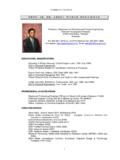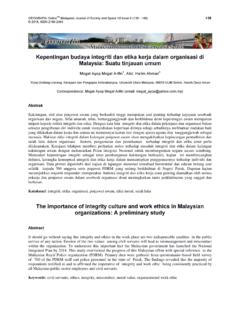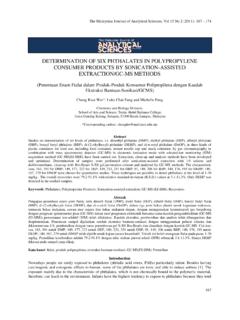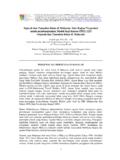Transcription of MINIMIZATION OF SUCROSE LOSSES IN SUGAR …
1 The Malaysian Journal of Analytical Sciences, Vol 12, No 3 (2008): 513 - 519 513 MINIMIZATION OF SUCROSE LOSSES IN SUGAR industry BY pH AND TEMPERATURE OPTIMIZATION Kornvalai Panpae1*, Wasna Jaturonrusmee1, Withawat Mingvanish1 , Chantana Nuntiwattanawong2, Surapon Chunwiset 2 , Kittisak Santudrob1 and Siriphan Triphanpitak1 1 Department of Chemistry , Faculty of Science , King s Mongkut s University of Technology Thonburi, Bangkok 10140, Thailand 2 Chaimongkol Refined SUGAR Company, Limited.( U-Thong Factory ), Supanburi Province 72160, Thailand * Corresponding author: Abstract Invert SUGAR has several disadvantage properties that play an important role in many food applications. It has a high affinity for water and is the cause of making products retain SUGAR also affects the caramelization process , producing a browning effect. In this study, the possibility of MINIMIZATION of SUCROSE inversion during the industrial production of SUGAR cane was investigated by the variation of the important parameters, temperature and pH of SUGAR cane juice for each of samples.
2 The amounts of SUCROSE and reducing SUGAR alerting during the SUCROSE inversion process were determined by the values of % Pol and % reducing SUGAR (% RS), respectively. Starting with the study of temperature and pH effects of the SUCROSE solution with the concentration of 16 Brix, used as a sample model, it was found that no change in amounts of reducing SUGAR and SUCROSE was observed at room temperature (34oC) in the pH range of 5-11. At pH 3, the amounts of reducing SUGAR increased and the amount of SUCROSE decreased as the time increased. These indicated that the process of SUCROSE inversion should better occur in more acidic solutions. Compared to the room temperature, it was found that the increment of temperature led to enhance the process of SUCROSE inversion. This was depicted by higher values of %RS and lower value of % Pol as the temperatures were elevated.
3 The experiments were also done with real SUGAR cane juice, first, last, and mixed juice. The tendency of changes of the amounts of reducing SUGAR and SUCROSE in SUGAR cane samples by varying temperature and pH were found to resemble to those for the sample model. The increment of temperatures have also affected on a reduction of amounts of SUCROSE in each SUGAR cane juice. In addition, it could be concluded that the acidity of the solution affects SUCROSE easier to be broken down to glucose and fructose molecules. Keywords : SUGAR industry , SUGAR cane juice , SUCROSE inversion , Reducing SUGAR ,Inverted SUCROSE Introduction Industrial processes aim at maximizing their production capacities while simultaneously improving the product quality and reducing operating costs. Usually, there exists a trade off between these requirements. This is particularly true in the production of high quality SUGAR from SUGAR cane crushing factory where high productivity at minimizing invert SUGAR is the most important issue.
4 SUGAR cane must be crushed to extract the juice. The crushing process must break up the hard nodes off the cane and flatten the stems. The juice is collected, filtered and sometimes treated and then boiled to drive off the excess water. In the process of juice treatment, juice should be filtered through a cloth before boiling in order to remove any solids such as dirt or particles of cane. The juice is neutralized with lime (Ca(OH)2) and then is boiled. After removal from the heat, the pans of juice are usually stirred rapidly to incorporate air and promote an even crystallization. For those with access to simple SUGAR measuring devices, this usually corresponds to a Brix ( SUGAR content) of 90-95%. The schematic representating process of SUGAR production is shown in Figure 1. Monitoring of total reducing SUGAR (reducing sugars plus hydrolyzed SUCROSE (Alves et al.))
5 , 2006)) is very important in relation to the SUGAR cane agro- industry , as it may provide information for evaluation of the raw matter and for quality control of the SUGAR manufacturing process. The inversion reaction is shown in Figure 2. Invert SUGAR syrup, an equimolecular mixture of glucose and fructose, is a valuable sweetener and is require by the food and pharmaceutical industries. High fructose syrups are in great demand as food and soft drink sweeteners. However, inversion of SUCROSE , an irreversible reaction, and thus the reaction rate is not influenced by the product accumulation, is, therefore, a major problem on SUCROSE LOSSES , across unit processes in the SUGAR industry . Kornvalai Panpae et al: MINIMIZATION OF SUCROSE LOSSES IN SUGAR industry BY pH AND TEMPERATURE OPTIMIZATION 514 Figure 1 The process diagram of SUGAR production. Fig. 1: The process diagram of SUGAR production.
6 Fig. 2: The inversion of SUCROSE . In the SUGAR refinery, determination of reducing sugars commonly relies on the Lane-Eynon titration or on the Somogyi-Nelson spectrophotomatric procedure, both relying on SUGAR oxidation by Cu2+ ion (Alves et al., 2006). There are a number of publications focusing on the determination and/or preventation of SUCROSE inversion (Khan and Rahman, 1996 ; Wienen and Shalleuberger, 1988 ; Eggleston et al.,2002 ; Eggleston and Monge, 2005 : Alves et al.,2006) as well as using enzymatic reactions (Almeida et al.,2005 ; Kurup et al.,2005). However, most of the investigations are based on single objective optimization, incorporating several objectives The Malaysian Journal of Analytical Sciences, Vol 12, No 3 (2008): 513 - 519 515 with some weight factor. Single objective function optimization approach is not efficient and also has the drawback of possibly losing certain optimal solution.
7 Sometimes it is very difficult to ensure for more complex, real-life problems. In this study, an attempt has been made to establish the optimum conditions to reduce invert SUGAR of SUGAR cane juice in U-Thong SUGAR industry Factory by optimizing pH and temperature compared with pure cane SUGAR . Materials and Methods Materials Mixed juice, limed juice and clear juice samples were obtained from an industrial SUGAR cane process line. The experiments were performed at the factory laboratory. Mixed juice was the first crushed juice mixed with juice from 4 crushings without chemical was added. Limed juice was the mixed juice which pH adjusted to neutral by lime. Other chemical : dry lead subacetate (Pb(CH3 COO)2Pb(OH)2) ; Analytical grade, pure cane SUGAR ( SUCROSE , C12H22O11); Analytical grade and methylene blue indicator solution ) were obtained from Asia Pacific Specialty Chemicals Co. Copper sulfate ( ) ; Analytical grade and Rochelle salt, sodium potassium tartate (COOK(CHOH) ) ; analytical grade were purchased from Ajax Chemical Co.
8 Apparatus A polarimeter with sodium-vapor lamp, thermostat and circulating pump was use to determine % Pol of the samples. The mean Brix of triplicate samples was measured using a Leica Abbe Mark II refractometer with a crosshair reticule. Brix is total dissolved solid in juice solution. The concentration (C) of SUCROSE in solution (g/100cm3) can be obtained by measuring brix of solution and value of C from Table of brix and grammes of SUCROSE per 100 cm3 of SUGAR solutions of Bureau of SUGAR Experiment Stations (1970). Methods The pH of standard SUCROSE solution (16 Brix) and raw juice samples (pH ) were adjusted from to with 10% HNO3 and 20% lime solution at the same temperature. The thermal stability of standard SUCROSE was studied by heating and stirring at 34 (room temperature), 60, 70, 80 and 90 C. For the juice, it was heated to 80 C only. Quality evaluation After the experiments, the standard SUCROSE and the juice samples were characterized base on their Brix, % Pol, % RS (reducing SUGAR ), TSS (total suspended solid) and TDS (total dissolved solid).
9 All experiments were repeated three times and the average value were used. Results and Discussion Analytical data of non-pH and temperature controlled SUGAR cane juice Physical and Chemical characteristics of the non-pH and temperature controlled juice are presented in Table 1. Table 1: Analytical data of mixed, lime and clear juice samples Technical data mixed juice lime juice clear juice (mgL-1) TS TSS TDS After neutralization, TS and TDS values of lime juice were rather high since adding lime, for neutralization, increases in total solids in SUGAR cane solution. Kornvalai Panpae et al: MINIMIZATION OF SUCROSE LOSSES IN SUGAR industry BY pH AND TEMPERATURE OPTIMIZATION 516 Effects of pH and temperature on the cane SUGAR (concentration 16 Brix) % RS and % Pol of the standard SUCROSE was studied at various pH ( , , and ) and temperatures at 34, 60, 70, 80 and 90 C.
10 The selected results (at temperature 30, 70 and 80 C) are shown in Figure 3-8. Fig. 3: % RS of standard SUCROSE at 34 C Fig. 4: % Pol of standard SUCROSE at 34 C Fig. 5: % RS of standard SUCROSE at 70oC Fig. 6: % Pol of standard SUCROSE at 70 C Fig. 7: % RS of standard SUCROSE at 80 C Fig. 8: % Pol of standard SUCROSE at 80 C time (hours) time (hours) time (hours) time (hours) time (hours) time (hours) The Malaysian Journal of Analytical Sciences, Vol 12, No 3 (2008): 513 - 519 517 SUCROSE is dextrorotatory, but the resulting mixture of glucose and fructose is slightly levorotatory, because the levorotatory fructose has s greater molar rotation than the dextrorotatory glucose.









